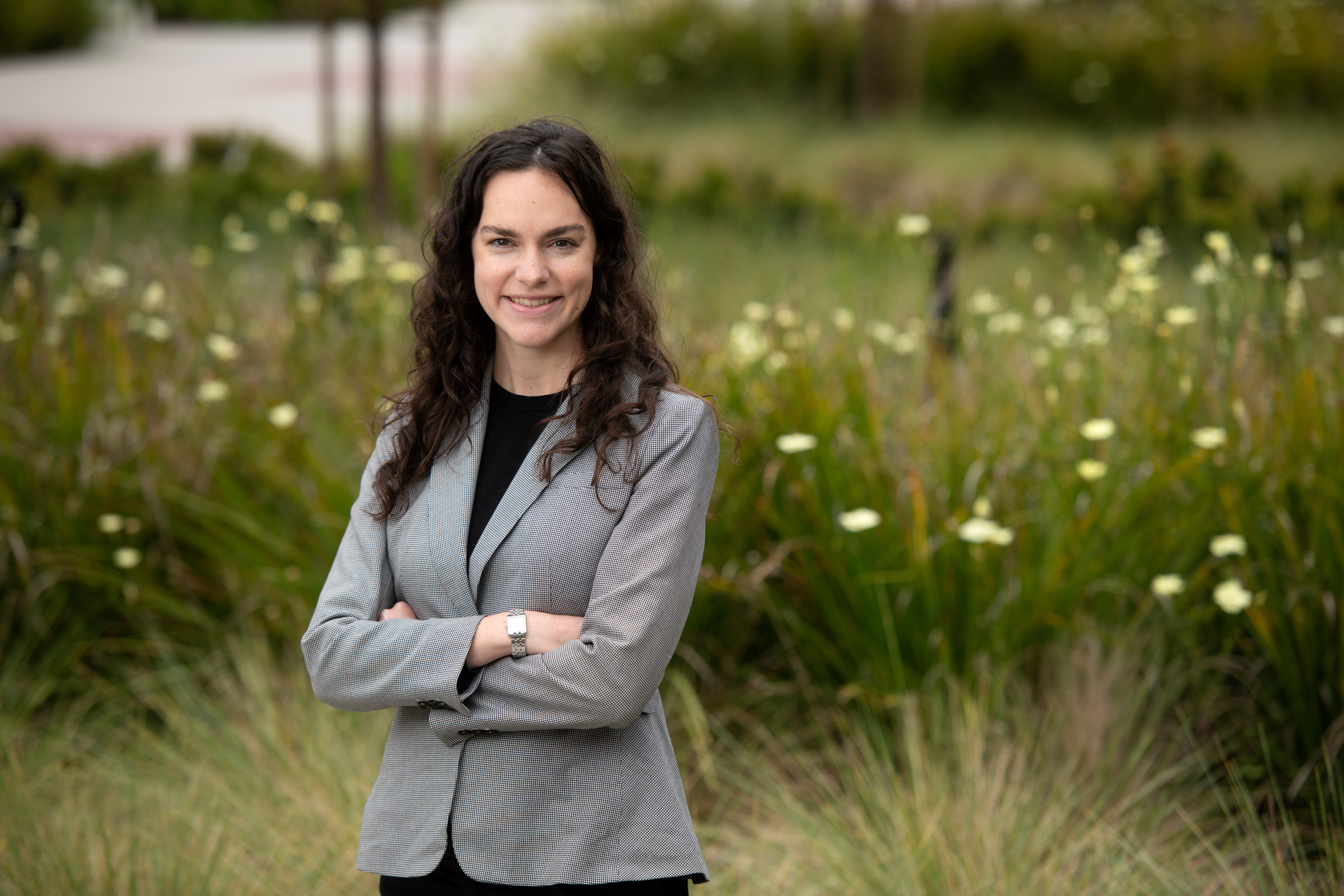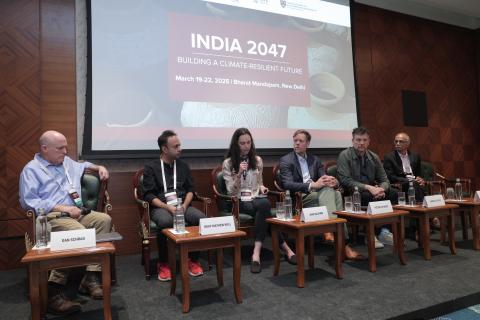From climate models to communities: how UC Irvine is delivering life-saving heatwave science

Professor Jane Baldwin of the UC Irvine Department of Earth System Science is discovering and interpreting all the factors at play when it comes to surviving deadly heatwaves, which stand to become more common and more intense as climate change continues unfolding.
You awaken after a sweltering, restless night, and as the day unfolds and the heat continues to climb, it hits you: if you don’t find a way to cool down, your health may be in jeopardy.
What do you do?
Professor Jane Baldwin of the UC Irvine Department of Earth System Science, whose group researches how human-driven climate change is amplifying the effects of extreme weather events like heatwaves, is working to help people better understand how bad heatwaves can be for individuals and those around them.
“Something I’m super invested in is how do we go from the climate models and their physical projections of what’s going to happen in the future to translating that into quantities that are more relevant for people?” Baldwin said.
It’s pressing research, especially as human-driven climate change continues unfurling unabated. Heatwaves are increasing in frequency and duration, and they kill more people than all other extreme weather events combined, including hurricanes and floods. Since 2000, over 260,000 people have died due to heat-related illness.
But it’s a struggle to know which solutions are the best fit for a population, because each solution needs to be tailored to include factors like age (the world’s population, Baldwin explained, is getting older on average, and older people tend to have a harder time negotiating heat than younger people), gender, socioeconomic and cultural backgrounds, and even the predominant physiology in a population (people that grew up in cooler, northern latitudes may respond differently to heat stress than those in places like sub-Saharan Africa where heat stresses are the norm).
Confusion extends into whether or not factors like humidity play a significant role in determining the deadliness of a heatwave – a quandary Baldwin and team of researchers addressed in a 2023 Environmental Health Perspectives study that revealed how disagreements between physiologists and epidemiologists regarding the role of humidity in heat-related mortality was a fundamental uncertainty in projecting future heat impacts.
“This kind of work I’m describing, which is often termed climate impacts work, sometimes researchers describe it as a bit of wild west,” said Baldwin, alluding to how hard it is to accurately describe the danger level of a heatwave, or any other climate change-related hazard, in a way that’s useful for individuals.
Baldwin is working with physiologists and other climate scientists to advance heat metrics. In a 2023 collaborative paper in Nature Communications, Baldwin and co-authors quantify what levels of physical activity are sustainable in heat, premised on the fact that to live humans need to do more than just be sedentary – they need to, among many other things, eat, work, exercise and reproduce.
A survey paper Baldwin co-authored that appeared this year in Nature Reviews Earth & Environment demonstrates agreement in such physiology-based heat thresholds between various models and experimental data, and shows that thresholds for human survivability in the heat have been very rarely reached up to this point – but will begin to be exceeded in hot and humid regions with climate change. This spells the need for novel heat adaptations.
At the start of the year, Baldwin got a call from an old colleague at her alma mater, Harvard University, asking if she wanted to visit India to participate in a climate workshop called India 2047: Building a Climate Resilient Future (2047 will be the 100th anniversary of India’s independence from Britain). Baldwin couldn’t say no, because India, she explained, is one of the hottest and most humid places humans call home, and is the place to go if a climate scientist wants to understand how heat impacts human health.

“India is one of the most populous places on Earth, and, in my view, it’s potentially ground zero for heat risk,” said Baldwin, who was in India to contribute her expertise as the country prepares for a future of more and more heatwaves. “The goal of the workshop was to get India thinking more concretely about adaptations that might help with their heat risk not two to three years in the future, but like 20 to 30 years in the future.”
Baldwin presented modeling results and learned about many heatwave factors specific to India that she had not yet accounted for, including how in some regions of the country people laboring outside will often find shade and rest from around noon to four o’clock in the afternoon.
“I never knew about that behavior, and without knowing about it I might be focused on daytime hours when I’m providing my projection of what outdoor heat risk will be,” said Baldwin. “But maybe it’s really the morning and the evening that matter the most when we develop projections.”
A workshop attendee representing an Indian union of informal women workers (SEWA, or the Self-Employed Women’s Association) described how families often rely on cows and chickens that they own, and how, if those animals are lost during heatwaves, this could also have an impact on human health outcomes.
It’s the kind of ethnographic information Baldwin wants to include in her risk modeling research, which is already revealing that the fraction of the year where it will be safe for people in places like India to farm could decrease to the point where almost half of summertime days will be too hot to harvest crops by hand.
Ideally, Baldwin wants to see modeling frameworks like hers deliver region-specific heat-related weather advisories and climate projections that include information about how long it’s safe to perform different activities outside for the full diversity of people exposed, especially the most vulnerable.
But Baldwin’s research isn’t just concerned with far-flung places like India – it’s also having an impact right here in Orange County.
One of her Ph.D. students, Haley Staudmyer, is doing research that bridges the divide between studying the basic physical science behind heatwaves and the role that scientists can play in a community as it sorts out how to adapt to a changing world.
“Haley is very interested in figuring out how her research can intersect with real-world problems that people are grappling with, and she’s very enthusiastic about communicating her research to the public,” said Baldwin.
That’s why Staudmyer is working with a grassroots community organization in nearby Santa Ana called GREEN-MPNA (Getting Residents Engaged in Empowering Neighborhoods – Madison Park Neighborhood Assocation), which aims to inform locals about the many environmental challenges they face, including heatwaves.
One heatwave solution Santa Ana currently offers residents are cooling centers – designated public spaces like libraries where anyone can go to get out of the heat. But not many Santa Ana residents use the centers, and the reasons why aren’t exactly clear.
“It’s something we need to figure out,” said Staudmyer, who started working with GREEN-MPNA in 2023 through UC Irvine’s CLIMATE Justice Initiative – a program that aims to develop collaborative relationships between scientists and the communities they study. “If we can’t get people to come to cooling centers, then we need to start investing big time in getting A/C into peoples’ houses.”
Understanding what Santa Ana residents tend to do during heatwaves is something Staudmyer is working out with the help of surveys and door-to-door advocates from GREEN-MPNA. Such surveying can help cities like Santa Ana provide better cooling solutions for its residents, something people like Sarahi Guttierez, a program manager with GREEN-MPNA, wants to do. “Are cooling centers being utilized?” Guttierez asked. “If not, what is it that we can do?”
One problem, Guttierez explained, is that cooling centers are not evenly distributed across the city – but that other social factors may explain low cooling center attendance, including childcare services that a cooling center may not be equipped to provide.
Working directly with community organizations like GREEN-MPNA is critical, Staudmyer said, because a researcher can’t deliver effective heat-related solutions unless there’s a level of trust between the scientists who offer solutions and impacted communities.
“I think maintaining a long-term relationship with the Santa Ana community is important,” said Staudmyer, who, even though her one-year CJI fellowship is over, still volunteers with Santa Ana’s Aspire, Learn, Mentor, Achieve K-12 youth science academy on Saturdays in addition to working with GREEN-MPNA. Staudmyer even plans to catalogue her work with them as one of the chapters of her dissertation, advised by both Baldwin and Professor Jun Wu from UC Irvine’s Joe C. Wen School of Population & Public Health.
Such relationship building is one of the tenants of CJI, which stipulates that in order to have an ethical relationship with a community, a scientist can’t just visit and then leave, they also need to develop a longstanding relationship with them and listen to their concerns.
It’s another layer of complexity in Baldwin's research, and an example of how her group's science makes its way into the world in an effective, though not always straightforward, way.
“I’m constantly walking this fine line of what can I do that has real societal relevance, but also what can I do that I can actually quantify and defend as robust in a scientific context,” said Baldwin. “And it can’t just be me waving my hands around saying there’s so much complexity, we can’t do anything.”
